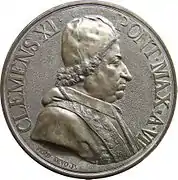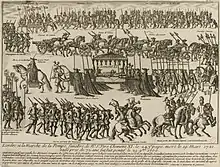Pope Clement XI
Pope Clement XI (Latin: Clemens XI; 23 July 1649 – 19 March 1721), born Giovanni Francesco Albani, was head of the Catholic Church and ruler of the Papal States from 23 November 1700 to his death in 1721.
Pope Clement XI | |
|---|---|
| Bishop of Rome | |
 | |
| Papacy began | 23 November 1700 |
| Papacy ended | 19 March 1721 |
| Predecessor | Innocent XII |
| Successor | Innocent XIII |
| Orders | |
| Ordination | September 1700 |
| Consecration | 30 November 1700 by Emmanuel-Theódose de la Tour d’Auvergne de Bouillon |
| Created cardinal | 13 February 1690 by Pope Alexander VIII |
| Personal details | |
| Birth name | Giovanni Francesco Albani |
| Born | 23 July 1649 Urbino, Papal States |
| Died | 19 March 1721 (aged 71) Rome, Papal States |
| Previous post |
|
| Coat of arms | |
| Other popes named Clement | |
Clement XI was a patron of the arts and of science. He was also a great benefactor of the Vatican Library; his interest in archaeology is credited with saving much of Rome's antiquity. He authorized expeditions which succeeded in rediscovering various ancient Christian writings and authorized excavations of the Roman catacombs.
Biography
Early life
Giovanni Francesco Albani was born in 1649 in Urbino to a distinguished family of Albanian and Italian origin.[1][2][3] His mother Elena Mosca (1630-1698) was a high-standing Italian of bergamasque origin, descended from the noble Mosca family of Pesaro.[4] His father Carlo Albani (1623-1684) was a patrician descended in part from the Staccoli family,[4] who were patricians of Urbino, in part from the Giordani,[4] who were nobles of Pesaro, and in part from the noble Albani family which had established itself in Urbino from northern Albania in the 15th century.[5][6]
Albani was educated at the Collegio Romano in Rome from 1660 onwards. He became a very proficient Latinist and gained a doctorate in both canon and civil law. He was one of those who frequented the academy of Queen Christina of Sweden. He would serve as a papal prelate under Pope Alexander VIII and was appointed by Pope Innocent XII as the Referendary of the Apostolic Signatura. Throughout this time, he also served as the governor of Rieti, Sabina and Orvieto.
Cardinalate
Pope Alexander VIII elevated him to the cardinalate in 1690 despite his protests and made him the Cardinal-Deacon of Santa Maria in Aquiro but he later opted for the Diaconia of San Adriano al Forno and later, as the Cardinal-Priest, for the titulus of San Silvestro in Capite. He was then ordained to the priesthood in September 1700 and celebrated his first Mass in Rome on 6 October 1700.
Pontificate
| Papal styles of Pope Clement XI | |
|---|---|
 | |
| Reference style | His Holiness |
| Spoken style | Your Holiness |
| Religious style | Holy Father |
| Posthumous style | None |
 The younger Albani
The younger Albani Medal depicting Clement XI
Medal depicting Clement XI Open letter from Kangxi Emperor to Pope Clement XI
Open letter from Kangxi Emperor to Pope Clement XI Portrait of Pope Clement XI
Portrait of Pope Clement XI Bust of Pope Clement XI at Santa Cecilia church, Rome
Bust of Pope Clement XI at Santa Cecilia church, Rome
Election to the papacy
After the death of Pope Innocent XII in 1700, a conclave was convoked to elect a successor. Albani was regarded as a fine diplomat known for his skills as a peacemaker and so was unanimously elected pope on 23 November 1700. He agreed to the election after three days of consultation.
Unusually, from the viewpoint of current practice, his election came within three months after his ordination as a priest and within two months after he celebrated his first Mass, though he had been a cardinal for ten years previously. Having accepted election after some hesitation, he was ordained a bishop on 30 November 1700 and assumed the pontifical name of "Clement XI". Cardinal protodeacon Benedetto Pamphili crowned him on 8 December 1700 and he took possession of the Basilica of Saint John Lateran on 10 April 1701.
Actions

Soon after his accession to the pontificate, the War of the Spanish Succession broke out.
In 1703 Pope Clement XI ordered a synod of Catholic bishops in northern Albania that discussed promotion of the Council of Trent decrees within Albanian dioceses, stemming conversions among locals to Islam and securing agreement to deny communion to crypto-Catholics who outwardly professed the Muslim faith.[1][7][2]
Despite initially holding an ambiguous neutrality in world affairs, Clement XI was later forced to name Charles, Archduke of Austria, as the King of Spain, since the imperial army had conquered much of northern Italy and was threatening Rome itself in January 1709.
By the Treaty of Utrecht that put an end to the war, the Papal States lost their suzerainty over the Farnese Duchy of Parma and Piacenza in favour of Austria, and lost Comacchio as well, a blow to the prestige of the Papal States.
In 1713 Clement XI issued the bull Unigenitus in response to the spread of the Jansenist heresy. There followed great upheaval in France, where apart from theological issues, a strong Gallican tendency persisted. The bull, which was produced with the contribution of Gregorio Selleri, a lector at the College of Saint Thomas, the future Pontifical University of Saint Thomas Aquinas, Angelicum,[8] condemned Jansenism by extracting and anathematizing as heretical 101 propositions from the works of Quesnel declaring them to be identical in substance with propositions already condemned in the writings of Jansenius.
The resistance of many French ecclesiastics and the refusal of the French parlements to register the bull led to controversies extending through the greater part of the 18th century. Because the local governments did not officially receive the bull, it was not, technically, in force in those areas – an example of the interference of states in religious affairs common before the 20th century.
During his reign as a pope the famous Illyricum Sacrum was commissioned, and today it is one of the main sources of the field of Albanology, with over 5,000 pages divided in several volumes written by the Jesuit Daniele Farlati and Dom Jacopo Coleti.
Clement XI made a concerted effort to acquire Christian manuscripts in Syriac from Egypt and other places in the Middle East, greatly expanding the Biblioteca Apostolica Vaticana's collection of Syriac works.[9]
Other activities
Clement XI extended the feast of Our Lady of the Rosary to the Universal Church of the Roman Rite in 1716.
Beatifications and canonizations
Clement XI confirmed the cultus of Ceslas Odrowaz (27 August 1712), Jakov Varingez (29 December 1700), John of Perugia (11 September 1704), Peregrine Laziosi (11 September 1702), Peter of Sassoferrato (11 September 1704), Buonfiglio Monaldi (1 December 1717), Pope Gregory X (8 July 1713) and Humbeline of Jully (1703). He formally beatified a number of individuals: Alexis Falconieri, Bartholomew degli Amidei and Benedict Dellantella, (1 December 1717) and John Francis Régis (24 May 1716).
He canonized Andrew Avellino, Catherine of Bologna, Felix of Cantalice and Pope Pius V on 22 May 1712, Humility on 27 January 1720, Sancha of Portugal on 10 May 1705, Theresa of Portugal on 20 May 1705, Stephen of Obazine in 1701 and Boniface of Lausanne in 1702.
Consistories
Clement XI created a total of 70 cardinals in 15 consistories. Notably, one cardinal of his own creation was Michelangelo dei Conti who became his immediate successor, Pope Innocent XIII.
Chinese Rites controversies
Another important decision of Clement XI was in regard to the Chinese Rites controversy: the Jesuit missionaries were forbidden to take part in honors paid to Confucius or the ancestors of the Emperors of China, which Clement XI identified as "idolatrous and barbaric", and to accommodate Christian language to pagan ideas under plea of conciliating the heathen.
Death and burial

Clement XI died in Rome on 19 March 1721 at 12:45pm and was buried in the pavement of St. Peter's Basilica rather than in an ornate tomb like those of his predecessors.
Contemporary influence
In his book "Journal of a Soul", while he was preparing for the Second Vatican Council, Pope John XXIII resolved to pray the Universal Prayer and recommends it.
Construction activity and patronage

Pope Clement XI had a famous sundial added in the church of Santa Maria degli Angeli e dei Martiri and had an obelisk erected in the Piazza della Rotonda in front of the Pantheon, and a port built on the Tiber River, the beautiful porto di Ripetta, demolished at the end of the 19th century.
He established a committee, overseen by his favourite artists, Carlo Maratta and Carlo Fontana, to commission statuary of the apostles to complete the decoration of San Giovanni in Laterano. He also founded an academy of painting and sculpture on the Campidoglio.
He also enriched the Vatican library with numerous Oriental codices and lent his patronage to the first archaeological excavations in the Roman catacombs. In his native Urbino he restored numerous edifices and founded a public library.
| Wikimedia Commons has media related to Clemens XI. |
Notes
- Frazee, Charles (2006). Catholics and Sultans: The Church and the Ottoman Empire 1453–1923. Cambridge University Press. pp. 167–168. ISBN 9780521027007. "...since the pope was of Albanian ancestry (demonstrated by his name of Albani)."
- Martucci, Donato (2010). I Kanun delle montagne albanesi: Fonti, fondamenti e mutazioni del diritto tradizionale albanese. Edizioni di Pagina. p. 154. ISBN 9788874701223. "Nel 1703, per iniziativa di Papa Clemente XI (che era di origini albanesi) si tenne il primo Concilio Nazionale Albanese, in cui si cercò di promuovere l'applicazione dei decreti del Concilio di Trento nelle diocesi albanesi, di arginare la marea di conversioni all'islam"
- http://en.radiovaticana.va/news/2014/09/21/fr_lombardi_papal_journey_a_blessing_for_all_albanians/1107019, ..."a silver portrait of Pope Clement XI – who belonged to the Albani family, so was traditionally of Albanian origin."
- "Family Tree of Giovanni Francesco Albani". geneanet.org. Retrieved 26 November 2018.
- Herbermann, Charles George; Columbus, Knights of; Committee, Catholic Truth (1913). The Catholic Encyclopedia. The New York Public Library: Robert Appleton Company. p. 255. Retrieved 05/12/2010. Check date values in:
|access-date=(help) - Williams, George L. (2004). Papal Genealogy: The Families and Descendants of the Popes. McFarland. p. 116. ISBN 9780786420711.
- Skendi, Stavro (1967). "Crypto-Christianity in the Balkan Area under the Ottomans". Slavic Review. 26 (2): 235–242. doi:10.2307/2492452. JSTOR 2492452.
- "Accessed 2-5-2012". .fiu.edu. Retrieved 2013-06-23.
- Heal, Kristian S. (2005). "Vatican Syriac Manuscripts: Volume 1". Hugoye: Journal of Syriac Studies. 8 (1). Archived from the original on 25 May 2011. Retrieved 17 April 2011.
Sources
- Frazee, Charles A. (2006) [1983]. Catholics and Sultans: The Church and the Ottoman Empire 1453-1923. Cambridge: Cambridge University Press. ISBN 9780521027007.
- Herbermann, Charles, ed. (1913). . Catholic Encyclopedia. New York: Robert Appleton Company.
- Rendina, Claudio (1983). I papi. Storia e segreti. Rome: Netwon & Compton. pp. 586–588.
| Wikisource has original works written by or about: Clement XI |
| Catholic Church titles | ||
|---|---|---|
| Preceded by Innocent XII |
Pope 23 November 1700 – 19 March 1721 |
Succeeded by Innocent XIII |